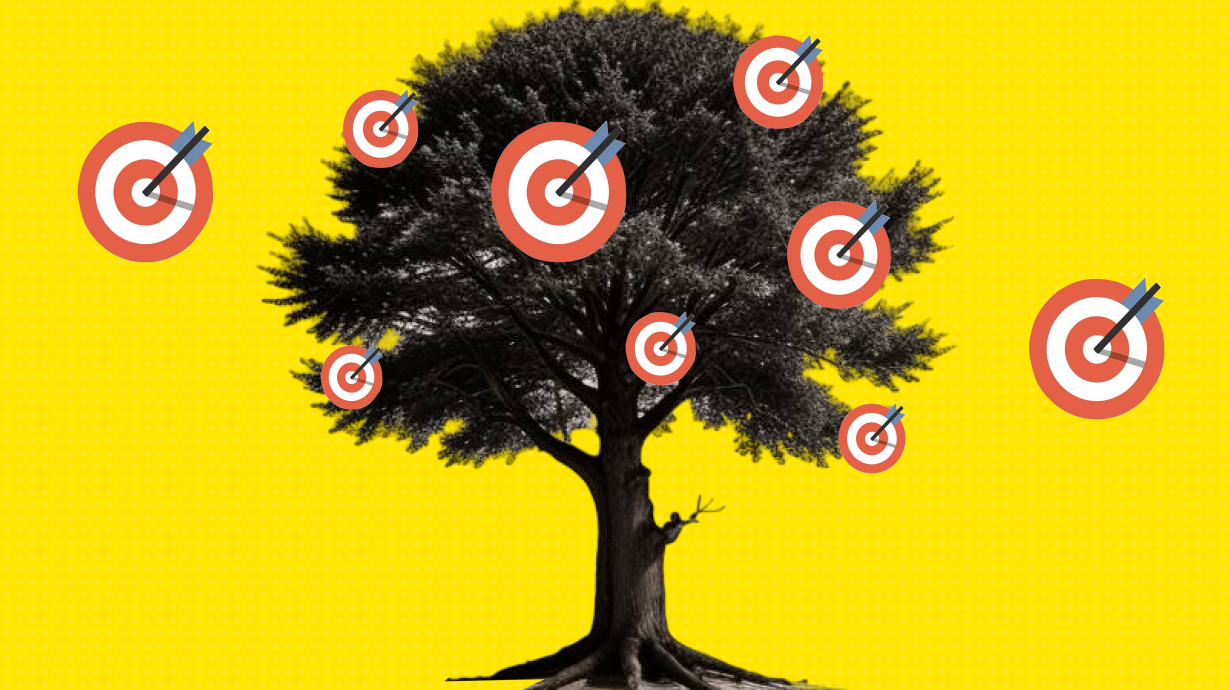📌 The Goal Tree is a visual tool used to represent the process of achieving a specific goal. It resembles an inverted tree, with the main goal at the top and branches representing the intermediate tasks and steps required to reach it.
This method is effective for creating action plans, organizing tasks for large projects, and visualizing the key milestones or metrics that lead to the ultimate goal.
At its core, a goal tree is a diagram that shows the main goal and the necessary conditions for achieving it. It highlights the relationships between these conditions, their dependencies, and their priorities.
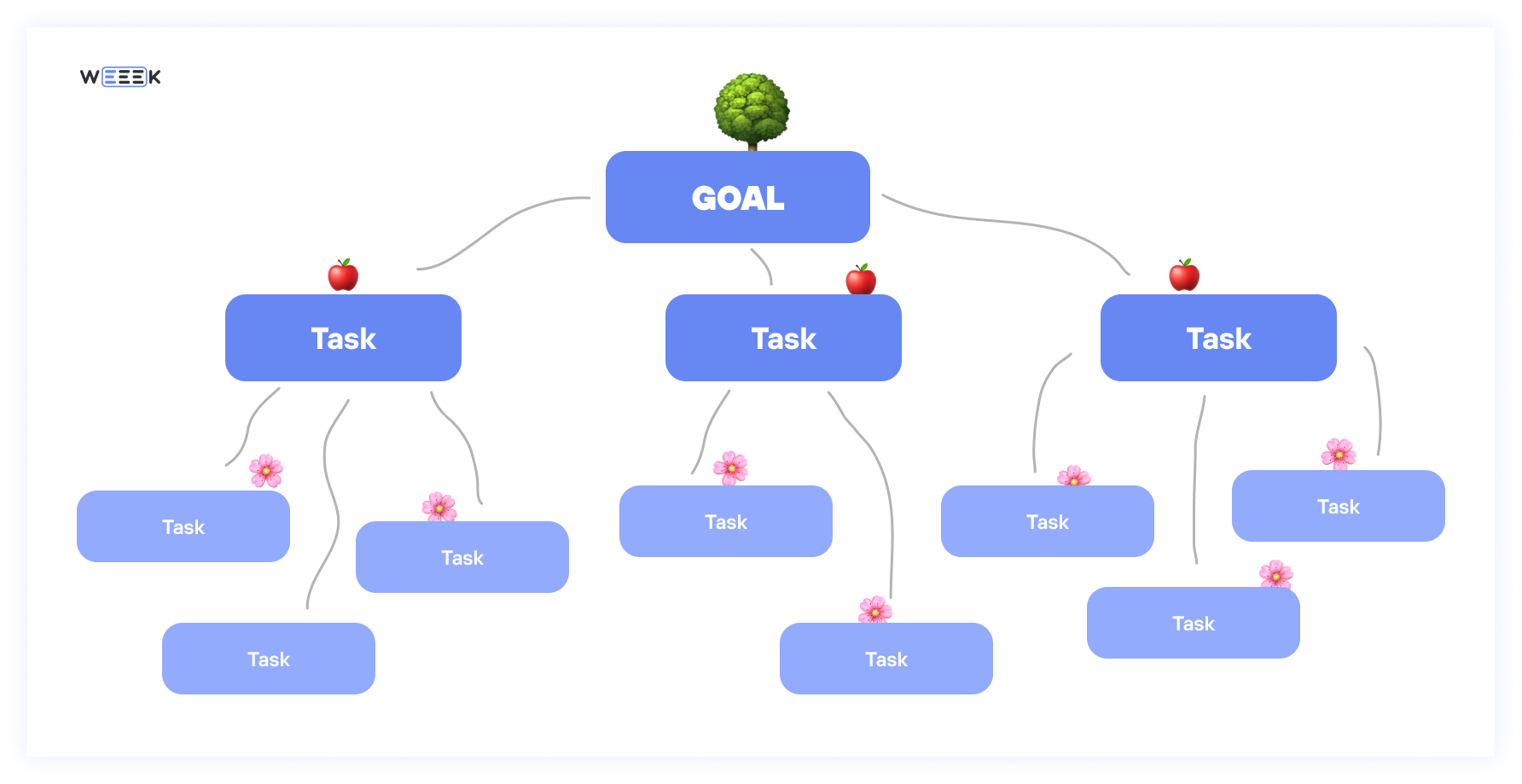
Where the Goal Tree Can Be Useful
- Personal Development. The goal tree is ideal for planning learning paths, career growth, events, home renovations, or travel. It helps break down large goals into manageable steps.
- Company Strategy. Visualizing the company's main goal and the steps to achieve it helps align the team, not just on the end goal, but also on the specific path to get there. Each team member can clearly see their area of responsibility and contribution to the overall success.
- Business Unit Management. The goal tree is useful for mapping how key business metrics (such as profit, user base, or retention) are connected to tactical metrics (such as customer lifecycle or average transaction value).
In summary, the goal tree is a powerful tool for clarifying how individuals contribute to processes, staying focused on the larger goal, and clearly understanding the steps needed to achieve it.
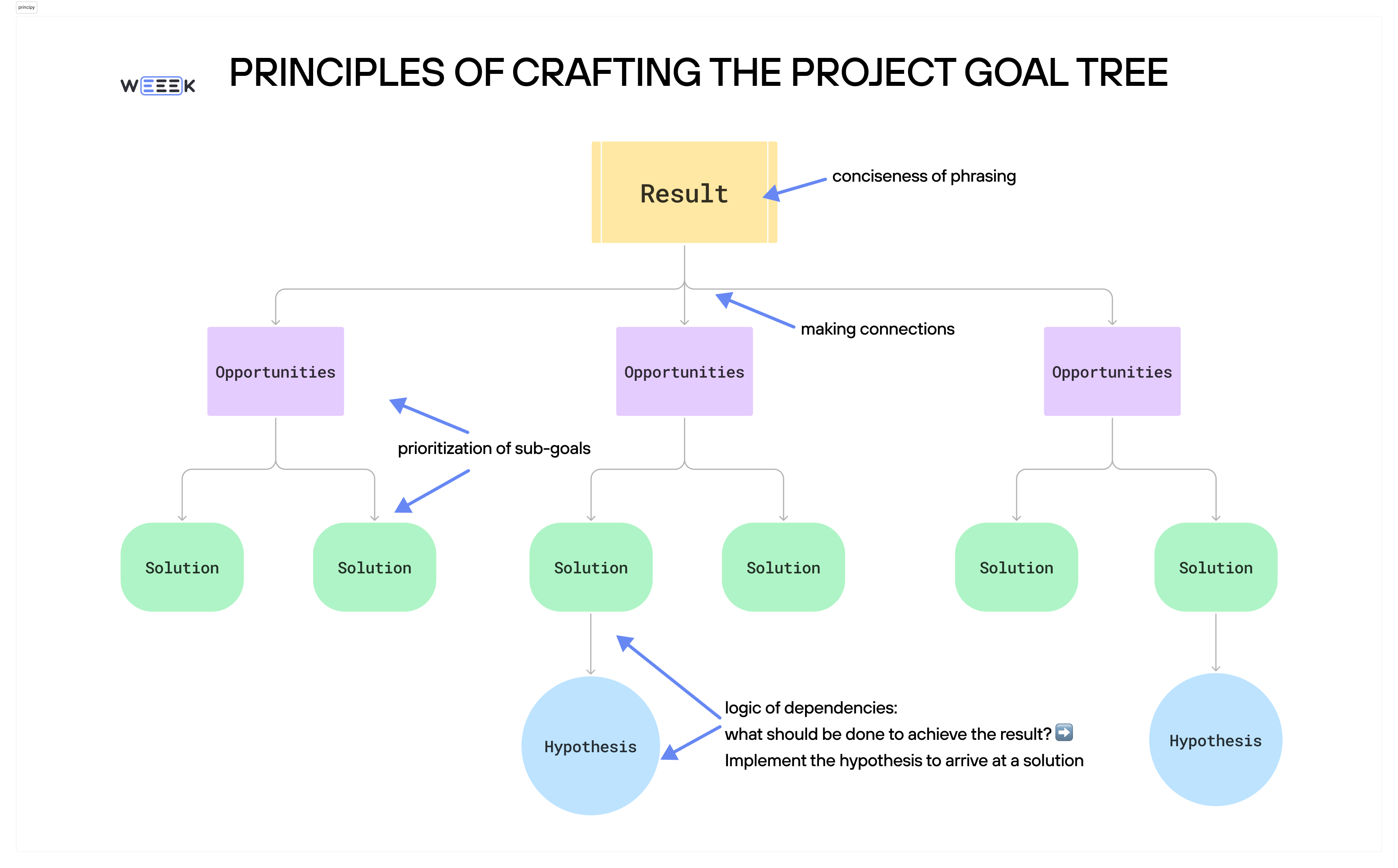
Why a Goal Tree Is Important
The main purpose of a goal tree is to visually organize information, specifically a large goal or long-term objective.
Here’s how a goal tree can help in achieving goals:
- Break down large goals into achievable tasks. It simplifies ambitious objectives—like launching a project or learning a new language—into manageable, actionable steps. This approach makes the goal less overwhelming and more attainable.
- Establish priorities and sequence. The goal tree provides a clear hierarchy. You begin with the main tasks and break them down into smaller, actionable steps. This structure helps identify what can be done immediately and what needs to be addressed later.
- Focus on details. High-level metrics alone may not reveal the underlying drivers. A goal tree shows how smaller tasks and metrics contribute to the overall goal, giving a clearer picture of what influences success.
- Identify links between stages and tasks. The goal tree highlights how different phases and tasks are interconnected, making it easier to understand the dependencies and how they influence one another.
- Spot bottlenecks. Breaking down a large strategic goal allows you to see areas of progress and identify where more effort is needed, helping to address gaps before they become major issues.
Benefits of a goal tree for teamwork
- Collective responsibility. Each team member understands how their tasks align with the broader goal and sees their role in contributing to the overall objective. This increases motivation and creates a stronger sense of individual impact.
- Clarity on shared objectives. In fast-changing environments where company strategies often shift, it can be difficult to stay focused. The goal tree keeps the main objective visible, acting as a constant guide for the team.
- Flexibility in decision-making. The goal tree allows the team to evaluate multiple pathways for progress. This helps the team quickly adjust direction when external conditions change, improving the decision-making process.
How to Build a Goal Tree
A goal tree is based on the principle of necessity, which connects the steps required (what needs to be done) to the main goal (what you want to achieve).
The logic of necessity can be summarized as: "To achieve A, we must accomplish B." For example, to buy a car, you need to save money, choose a car, and sign a contract.
Here’s how to effectively create a goal tree:
Define the overall goal
Start by clearly defining your main goal. This goal should describe the final desired outcome. Using the SMART method is highly effective for both project management and personal goals.
A SMART goal is:
- Specific: clear, with no vague or ambiguous wording, and with defined outcomes.
- Measurable: quantifiable, with specific metrics to track progress.
- Achievable: realistic, considering your resources and experience.
- Relevant: aligned with your broader mission or objectives.
- Time-bound: has a clear deadline.
Here’s an example of what works and what doesn’t:
❌ "Learn English" — this is vague, unmeasurable, and lacks both a deadline and clear purpose.
✅ "Prepare for the IELTS exam within 10 months to obtain a C1-level certificate for job opportunities abroad" — this is specific, time-bound, measurable, relevant, and realistic
It’s helpful to write this goal in detail to keep your focus clear and motivation high. However, for the goal tree itself, a more concise version like "Obtain IELTS C1 certificate" works better. This should be your final outcome at the top of the tree.

Break it into sub-goals
Next, think about what actions are needed to achieve your main goal.
For example, obtaining an IELTS certificate requires passing the exam, which means you need a strong command of the English language.
You can break this down into two key components:
- 1. Enrolling in an English course with a teacher who understands the certification process.
- 2. Self-study to reinforce the material you learn in class.
These become your two main sub-goals, which can then be further detailed.
For the first sub-goal, break it down further: research courses, select a teacher, and decide on a study schedule.
For the second sub-goal, break it down into actions like: watch films in English, read books, study grammar, and practice outside of lessons.
Consider the interconnections
The goal tree helps you visualize how tasks are interconnected. You’ll better understand the impact of your current actions on future outcomes, which keeps you on track and efficient.
For example, your two sub-goals (the English course and self-study) are closely linked. Self-study helps reinforce what you learn in the course, but the structured guidance of a teacher is essential for understanding the exam’s specific requirements. Both components are necessary to reach your main goal.
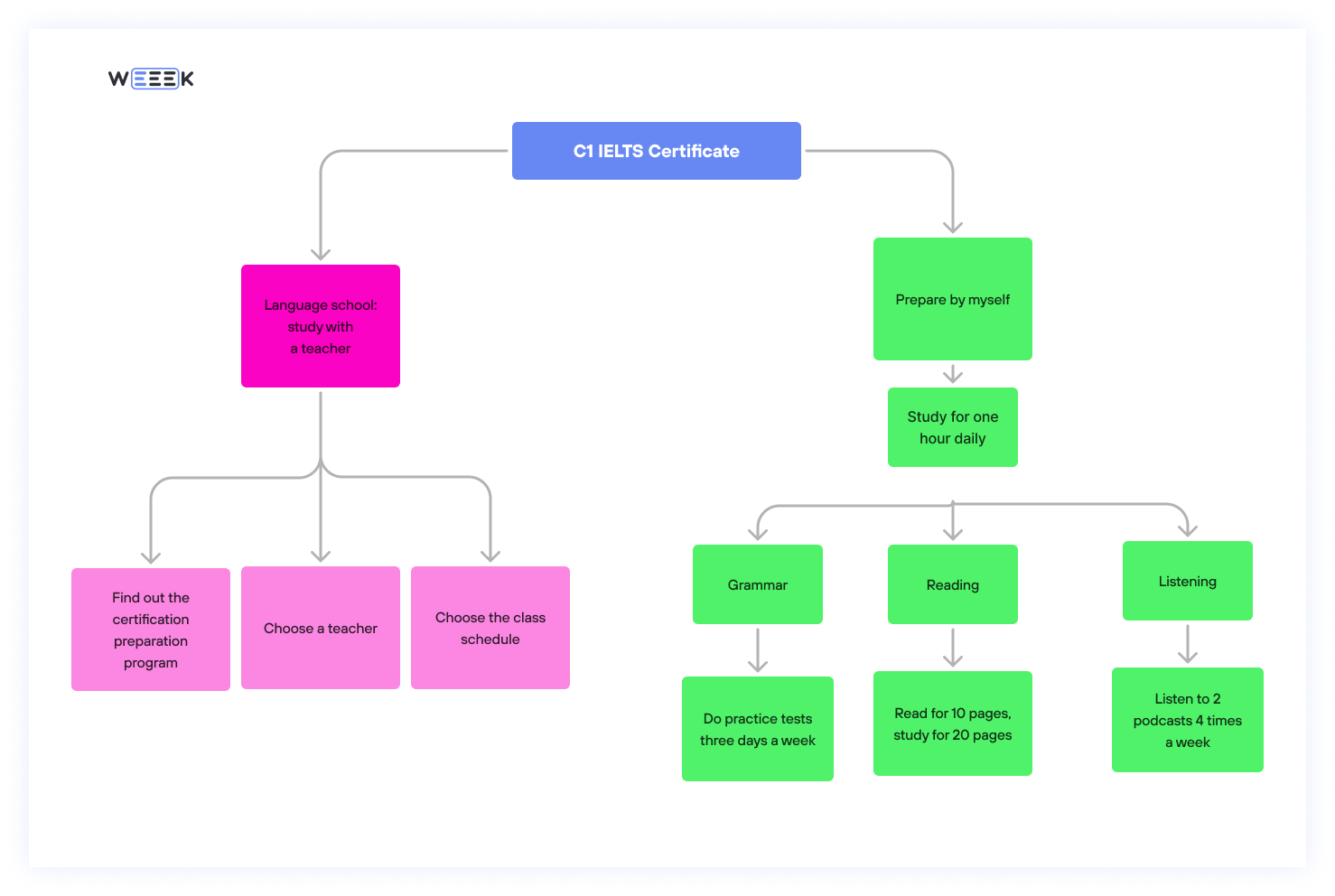
Prioritize
It’s crucial to identify which tasks need to be completed first and which can wait. Prioritizing is key to staying focused on the most impactful actions. To help prioritize, ask yourself:
- Which task is essential to moving toward my overall goal?
- What depends on this task being completed first?
- Is this task urgent?
- Do I have the resources to complete it now?
Several methods can assist in prioritizing tasks, including:
- Eisenhower Matrix. Classifies tasks based on urgency and importance.
- MoSCoW Method. Ranks tasks as Must Have (essential), Should Have (important), Could Have (nice-to-have), and Would Have (optional).
- Weighted Scoring Method. Compares different options based on their relative importance to choose the best course of action.
In our example, passing the IELTS exam is the primary objective. To succeed, you need to meet the exam's criteria, which are best understood by a specialized English school. Therefore, the top priority is finding a school that prepares students for the exam. All other preparations, such as self-study, will revolve around this central task.
By following these steps, you can build a clear, structured goal tree that guides you toward your objectives, keeps you focused, and helps you make informed decisions along the way.
Advantages and Disadvantages of Using a Goal Tree
Advantages
✅ Clarity. Even with multiple branches, a goal tree is easy to follow. Each branch stems from a specific task and logically extends it, without getting tangled with others. The structure clearly shows how all tasks are interconnected and how they align with the main goal.
✅ Simplicity. Understanding a goal tree doesn't require prior knowledge of the method or expertise in the subject matter. It's also easy to create—simply define the goal and map out the sub-goals using arrows.
✅ Efficiency. A goal tree can be built quickly, often within the span of a single planning meeting.
✅ Visual appeal. The natural structure of a tree is aesthetically pleasing, even when there are many branches. As noted in Oppenheimer, "Trees have the most inspiring structures." This makes a goal tree not only practical but also visually engaging.
Disadvantages
❌ Difficult to maintain. Keeping a goal tree current can be a complex and ongoing task, especially for large projects with lots of moving parts. It may require a dedicated person or process to manage updates.
❌ Requires constant updates. Related to the maintenance issue, a goal tree needs regular updates as projects evolve, which can add extra workload for the team.
❌ Risk of subjectivity. Mistakes can occur in defining the main goal, prioritizing tasks, or identifying connections between them. These errors could cause disagreements within the team. However, this issue is often rooted in planning rather than the goal tree itself.
Tips from WEEEK
- Use different colors to distinguish between goals at various levels, making the structure easier to interpret.
- Leverage templates and tools, such as those available in Figma, to create your goal tree.
- Regularly review and update the goal tree to ensure it stays relevant and aligned with current objectives.

Examples of Use
In Personal Life
We’ve already covered an example with learning English, and here is the resulting tree.

Now, let’s look at an example of organizing a birthday party — a large, vibrant event where it’s essential to plan ahead. You can sketch out a similar tree on a sheet of paper, thinking through all the details that need to be taken care of.
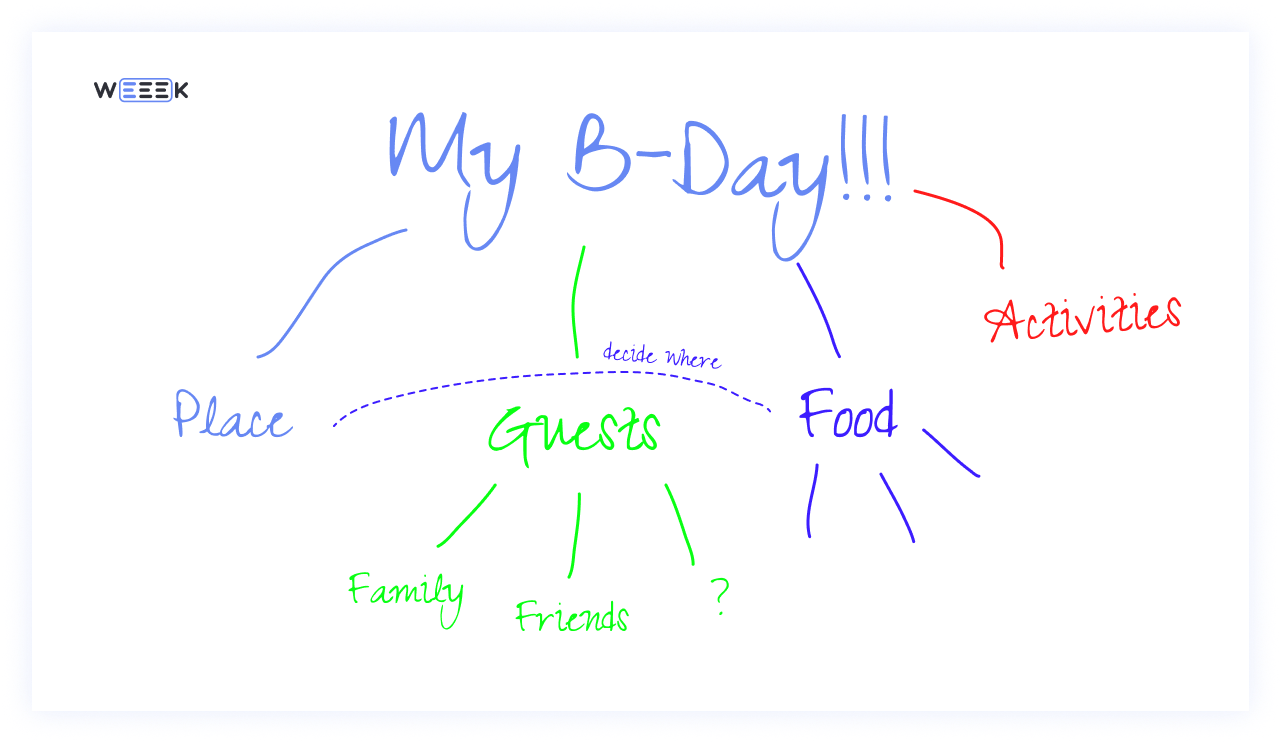
In a Project
To create a project goal tree, you need to develop a high-level plan, starting with the main goal and key tasks.
We don’t dive into details. The tree should reflect what needs to be done to achieve the main goal — the essential tasks and parts of the project's content.

This kind of tree can also be replicated on a Kanban board, where it will be easy to manage in the workflow. You can immediately assign deadlines and prioritize future plans.
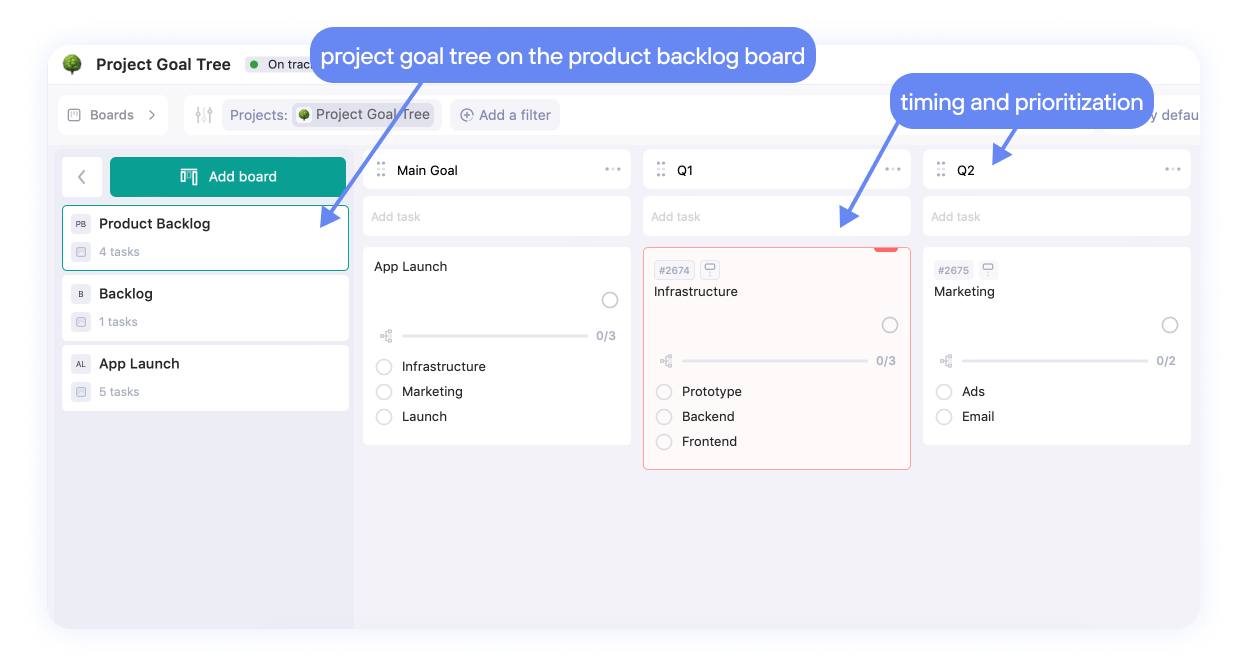
Note that the main goal is the primary task. Sub-goals are subtasks of the same task. Subtasks may have their own sub-subtasks. Now you can track the status of each sub-goal separately and monitor the overall processes.
Goal Tree Overview
- A goal tree is a visual tool for representing goals, structured like an inverted tree. The main goal sits at the top, with branches extending into the steps required to achieve it.
-
This method helps break down large goals into smaller, manageable tasks, visualize the process, and distribute responsibilities within a team. It allows you to prioritize tasks, see the connections between them, and track progress toward the overall goal. In a team setting, it fosters accountability among members.
-
A goal tree is concise, easy to create, and clear for all participants.
-
For it to be effective, the goal tree needs regular updates, with sub-goals adjusted and progress tracked.
-
The process of building a goal tree includes four steps: defining the main goal, breaking it down into sub-goals, identifying interconnections, and setting priorities.








